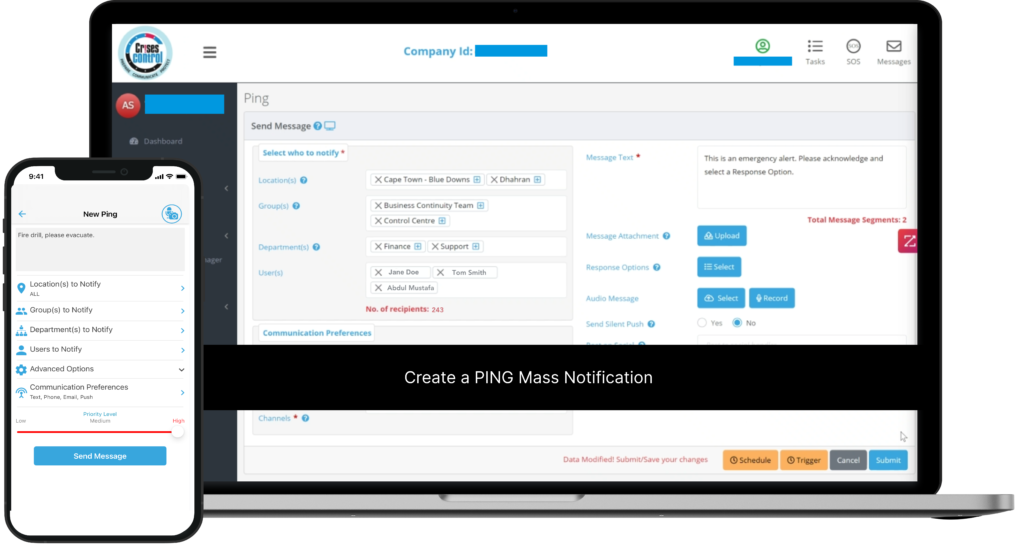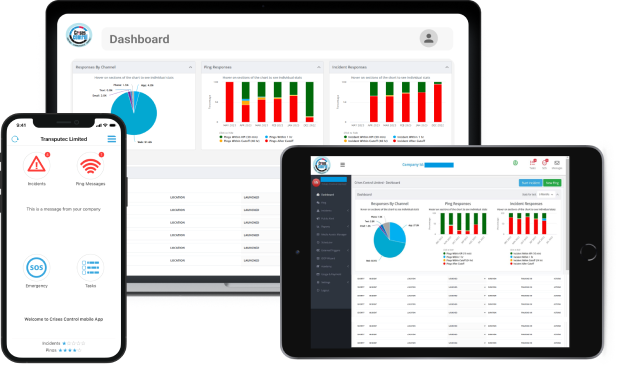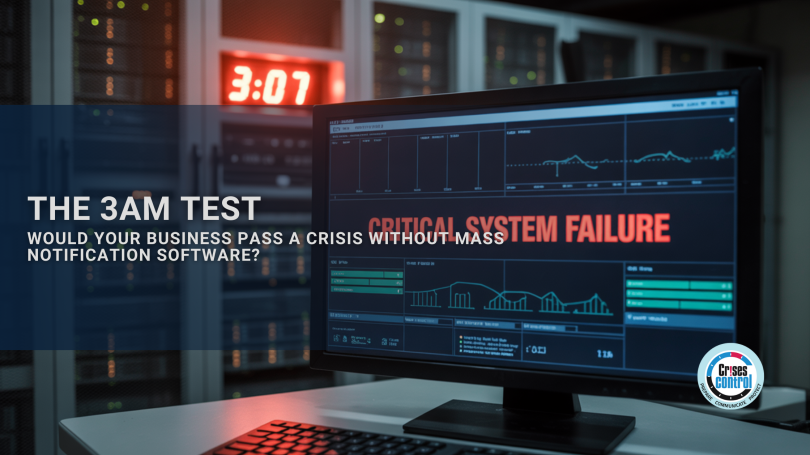Written by Anneri Fourie | Crises Control Executive
What Happens When No One Picks Up the Phone?
You’re not in the office. Your leadership team is scattered. And something serious has just gone wrong; a cyberattack, a power outage, a gas leak. One of your frontline managers spots the issue, but has no clear instructions on what to do or who to inform. Phone calls go unanswered. Messages get missed. Half your team doesn’t even know there’s a problem.
This is the kind of situation where businesses often realise, too late, that they’re missing something critical: mass notification software. Without a fast, reliable way to reach the right people at the right time, even small incidents can spiral out of control.
We call it the 3AM Test. It’s not just about whether your systems are resilient. It’s about how quickly you can coordinate, communicate, and act, especially when no one’s at their desk.
In this blog, we’ll look at what typically goes wrong during out-of-hours incidents, how mass notification software changes the outcome, and how Crises Control helps your business take control when it matters most.
The Real Problem: Delay and Uncertainty in a Crisis
When something serious happens, whether it’s a fire alarm at headquarters or a ransomware attack at 2AM, the real damage is rarely caused by the incident itself. It’s the time lost between discovering the problem and taking action.
Most businesses still rely on scattered communication tools: WhatsApp chats, call trees, email alerts, and a bit of hope. These methods might work on a quiet Tuesday. But during a crisis? They break down quickly. People miss calls. Emails are buried. Messages are inconsistent. And no one knows who’s doing what.
The result? Confusion. Paralysis. Missed opportunities to contain the issue early.
That’s why communication must be part of your core continuity strategy, not just an afterthought.
What a 3AM Crisis Looks Like Without Mass Notification Software
Let’s break it down:
00:00 – A Major Incident Occurs
A data centre goes offline due to a cooling failure. No automated alert is set up.
00:15 – Someone Notices Something’s Wrong
An IT engineer sees systems going down and calls their manager. They don’t pick up.
00:45 – Calls and Messages Start Going Out
The team starts phoning around. Some answer. Some don’t. One person sends a group email. Another sends a Slack message. Confusion builds.
01:30 – Senior Management Gets Involved
By the time the core team is looped in, the outage has spread. Customers are affected. No one knows what steps have already been taken.
03:00 – The Impact Is Clear
The business is scrambling. Critical data is compromised. Customers are demanding answers. Internally, everyone’s asking the same thing: why didn’t we know sooner?
This isn’t an extreme scenario. It’s a pattern seen across industries, especially in companies that haven’t invested in proper emergency alert software for businesses.
What Changes With Crises Control
With mass notification software from Crises Control, the same scenario unfolds very differently.
00:00 – Incident Detected
A pre-configured integration between Crises Control and your monitoring system picks up the fault.
00:01 – Instant Notification Sent
Within seconds, an alert is sent to everyone who needs to know via SMS, push notification, voice call, email and desktop. The message is clear, includes instructions, and is tailored by location and role.
00:03 – Acknowledgements Roll In
Staff confirm receipt with a simple tap. Anyone who doesn’t respond is automatically escalated. You see acknowledgements in real time.
00:05 – Response Team Mobilised
A predefined incident workflow kicks in. Tasks are assigned. Roles are clear. The crisis team is fully activated without needing a single manual call.
01:00 – Containment in Progress
While other businesses would still be trying to organise a call, your teams are already working the recovery plan.
That’s the difference between a crisis you control, and one that controls you.
Why Two-Way Communication Is a Game Changer
Mass alert systems that only send out messages are outdated. Real crisis management depends on feedback.
Crises Control’s mass notification software with two-way communication allows you to track who’s seen the message, who’s acknowledged it, and what action they’ve taken. You can escalate automatically when there’s no response, redirect based on feedback, and adapt your instructions on the fly.
This gives you far more than reach, it gives you oversight.
How Mass Notification Software Supports Business Continuity
Modern continuity planning relies on keeping people informed, accountable, and aligned. Here’s how Crises Control supports that across your organisation:
1. Multi-Channel Delivery
Your teams don’t all check the same inbox. Crises Control ensures alerts go out across all major channels; SMS, app, voice, desktop, and email, increasing delivery rates, especially during unsociable hours.
2. Role-Based Targeting
Send the right message to the right people. Whether it’s a cyber issue affecting only IT or a flood risk to your warehouse team, Crises Control lets you segment alerts by role, location, or function.
3. Pre-Built Templates and Playbooks
Don’t waste time writing alerts when the pressure’s on. Crises Control comes with 200+ templates for common crisis scenarios: from data breaches to extreme weather to transport disruption.
4. Integrated Incident Management
Notifications are just the start. Crises Control lets you assign tasks, track progress, and monitor resolution all in one place. This turns alerts into action, fast.
5. Global Coordination, Local Control
If you operate across time zones, Crises Control makes it easy to localise alerts. Whether you’re managing a single site or a global network, you can customise messages while maintaining a consistent strategy.
Interested in our Ping Mass Notification Software?
Efficiently alert everyone in seconds at scale with our Mass Notification Software – PING, get the message out fast and ensure rapid response and recovery.

What Sets Crises Control Apart
Built for Real-World Crises
This isn’t just a messaging tool. Crises Control was designed with crisis professionals to meet real operational needs. It supports compliance with ISO 22301 and is GDPR-ready out of the box.
Scalable for Any Organisation
From local authorities to large enterprises, Crises Control scales to fit your needs. If you’re looking for affordable mass notification solutions for small businesses, there are flexible pricing models that don’t compromise on capability.
Easy to Use, Quick to Deploy
Your crisis software shouldn’t be a crisis to operate. Crises Control is simple to use, even under pressure. With quick onboarding and 24/7 support, you’re never left to figure things out alone.
Key Questions to Ask Before Choosing a Provider
Before you commit to any notification platform, consider:
- Can you send alerts in under 60 seconds?
- Is there two-way communication and acknowledgement tracking?
- Does it integrate with your monitoring systems or business continuity tools?
- Can you tailor alerts by role or location?
- Is support available during a live incident, not just during setup?
Crises Control answers yes to all of these, and more.
Take the 3AM Test Now — Not After the Crisis
If you don’t know how your business would respond to an incident in the middle of the night, it’s time to find out, while you still have control.
Crises Control helps organisations run realistic test drills to expose communication gaps before a real incident does. Whether you need to improve your current processes or build from scratch, we’re here to support every step of your continuity journey.
Conclusion: Be Ready Before the Wake-Up Call
The hardest part of any crisis is the first hour, especially when no one knows what’s happening. Mass notification software gives you the speed, structure, and clarity to act, even when everything else is uncertain.
Crises Control doesn’t just help you react, it helps you lead.
Book your free demo today and see how Crises Control can support your business when it matters most.
Request a FREE Demo

